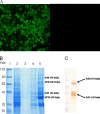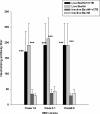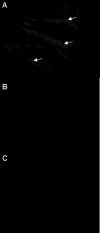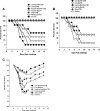Gastrointestinal delivery of baculovirus displaying influenza virus hemagglutinin protects mice against heterologous H5N1 infection
- PMID: 20071572
- PMCID: PMC2838147
- DOI: 10.1128/JVI.02175-09
Gastrointestinal delivery of baculovirus displaying influenza virus hemagglutinin protects mice against heterologous H5N1 infection
Abstract
The recent outbreaks of influenza A H5N1 virus in birds and humans have necessitated the development of potent H5N1 vaccines. In this study, we evaluated the protective potential of an immediate-early promoter-based baculovirus displaying hemagglutinin (BacHA) against highly pathogenic avian influenza (HPAI) H5N1 virus infection in a mouse model. Gastrointestinal delivery of BacHA significantly enhanced the systemic immune response in terms of HA-specific serum IgG and hemagglutination inhibition (HI) titers. In addition, BacHA vaccine was able to significantly enhance the mucosal IgA level. The inclusion of recombinant cholera toxin B subunit as a mucosal adjuvant along with BacHA vaccine did not influence either the systemic or mucosal immunity. Interestingly, an inactivated form of BacHA was able to induce only a negligible level of immune responses compared to its live counterpart. Microneutralization assay also indicated that live BacHA vaccine was able to induce strong cross-clade neutralization against heterologous H5N1 strains (clade 1.0, clade 2.1, and clade 8.0) compared to the inactivated BacHA. Viral challenge studies showed that live BacHA was able to provide 100% protection against 5 50% mouse lethal doses (MLD(50)) of homologous (clade 2.1) and heterologous (clade 1) H5N1. Moreover, histopathological examinations revealed that mice vaccinated with live BacHA had only minimal bronchitis in lungs and regained their body weight more rapidly postchallenge. Furthermore, immunohistochemistry results demonstrated that the live BacHA was able to transduce and express HA in the intestinal epithelial cells in vitro and in vivo. We have demonstrated that recombinant baculovirus with a white spot syndrome virus (WSSV) immediate-early promoter 1 (ie1) acted as a vector as well as a protein vaccine and will enable the rapid production of prepandemic and pandemic vaccines without any biosafety concerns.
Figures








Similar articles
-
Protective immunity against influenza H5N1 virus challenge in mice by intranasal co-administration of baculovirus surface-displayed HA and recombinant CTB as an adjuvant.Virology. 2008 Oct 25;380(2):412-20. doi: 10.1016/j.virol.2008.08.002. Epub 2008 Sep 10. Virology. 2008. PMID: 18786689
-
Reverse micelle-encapsulated recombinant baculovirus as an oral vaccine against H5N1 infection in mice.Antiviral Res. 2010 May;86(2):180-7. doi: 10.1016/j.antiviral.2010.02.315. Epub 2010 Feb 12. Antiviral Res. 2010. PMID: 20153776
-
Cross-protective efficacy of bivalent recombinant baculoviral vaccine against heterologous influenza H5N1 challenge.Vaccine. 2013 Feb 27;31(10):1385-92. doi: 10.1016/j.vaccine.2013.01.003. Epub 2013 Jan 14. Vaccine. 2013. PMID: 23328313
-
Production of a novel influenza vaccine using insect cells: protection against drifted strains.Influenza Other Respir Viruses. 2007 Jan;1(1):35-40. doi: 10.1111/j.1750-2659.2006.00007.x. Influenza Other Respir Viruses. 2007. PMID: 19453478 Free PMC article. Review.
-
Baculovirus Surface Display of Immunogenic Proteins for Vaccine Development.Viruses. 2018 May 31;10(6):298. doi: 10.3390/v10060298. Viruses. 2018. PMID: 29857561 Free PMC article. Review.
Cited by
-
Simple and rapid plaque assay for recombinant baculoviruses expressing influenza hemagglutinin.Sci Prog. 2021 Jan-Mar;104(1):368504211004261. doi: 10.1177/00368504211004261. Sci Prog. 2021. PMID: 33787402 Free PMC article.
-
Mucosal delivery of ACNPV baculovirus driving expression of the Gal-lectin LC3 fragment confers protection against amoebic liver abscess in hamster.Int J Biol Sci. 2011;7(9):1345-56. doi: 10.7150/ijbs.7.1345. Epub 2011 Nov 1. Int J Biol Sci. 2011. PMID: 22110386 Free PMC article.
-
Immunobiology of influenza vaccines.Chest. 2013 Feb 1;143(2):502-510. doi: 10.1378/chest.12-1711. Chest. 2013. PMID: 23381315 Free PMC article. Review.
-
Recombinant baculovirus associated with bilosomes as an oral vaccine candidate against HEV71 infection in mice.PLoS One. 2013;8(2):e55536. doi: 10.1371/journal.pone.0055536. Epub 2013 Feb 4. PLoS One. 2013. PMID: 23390538 Free PMC article.
-
Neutralizing epitopes of influenza virus hemagglutinin: target for the development of a universal vaccine against H5N1 lineages.J Virol. 2010 Nov;84(22):11822-30. doi: 10.1128/JVI.00891-10. Epub 2010 Sep 15. J Virol. 2010. PMID: 20844051 Free PMC article.
References
-
- Abe, T., H. Takahashi, H. Hamazaki, N. Miyano-Kurosaki, Y. Matsuura, and H. Takaku. 2003. Baculovirus induces an innate immune response and confers protection from lethal influenza virus infection in mice. J. Immunol. 171:1133-1139. - PubMed
-
- Bright, R. A., D. K. Shay, B. Shu, N. J. Cox, and A. I. klimov. 2006. Adamantane resistance among influenza A (H3N2) viruses isolated early duringthe 2005-2006 influenza season in the United states. JAMA 295:891-894. - PubMed
-
- Bright, R. A., D. M. Carter, C. J. Crevar, F. R. Toapanta, J. D. Steckbeck, K. S. Cole, N. M. Kumar, P. Pushko, G. Smith, T. M. Tumpey, and T. M. Ross. 2008. Cross-clade protective immune responses to influenza viruses with H5N1 HA and NA elicited by an influenza virus-like particle. PLoS One 3:e1501. - PMC - PubMed
-
- Centers for Disease Control and Prevention. 2004. Prevention and control of influenza: recommendations of the Advisory Committee on Immunization Practices (ACIP). MMWR Morb. Mortal. Wkly. Rep. 53:1-40. - PubMed
Publication types
MeSH terms
Substances
LinkOut - more resources
Full Text Sources
Other Literature Sources
Medical
Miscellaneous

